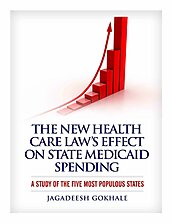This study estimates and compares potential increases in Medicaid expenditures from PPACA by the five most populous states: California, Florida, Illinois, New York, and Texas. State Medicaid spending is projected to increase considerably even without PPACA in California, Florida, and Texas, with smaller increases in Illinois and New York. With PPACA, projected spending is actually reduced for California, while spending increases are positive and large for Florida and Texas. Both Illinois and New York have the potential for considerably higher enrollments and increased expenditures.
My estimates of the states’ PPACA Medicaid burdens are considerably larger than those reported elsewhere, such as in the Kaiser Family Foundation’s study, which appears to have used fixed enrollment rates for new- and old-eligibles based on 2007 data. In this study, the individual mandate’s impact depends on historical enrollment trends — stronger where enrollment rates were low or declining, weaker where they were high and increasing. Thus, methodological differences may underlie the sizable differences in estimates of states’ additional costs from PPACA.


